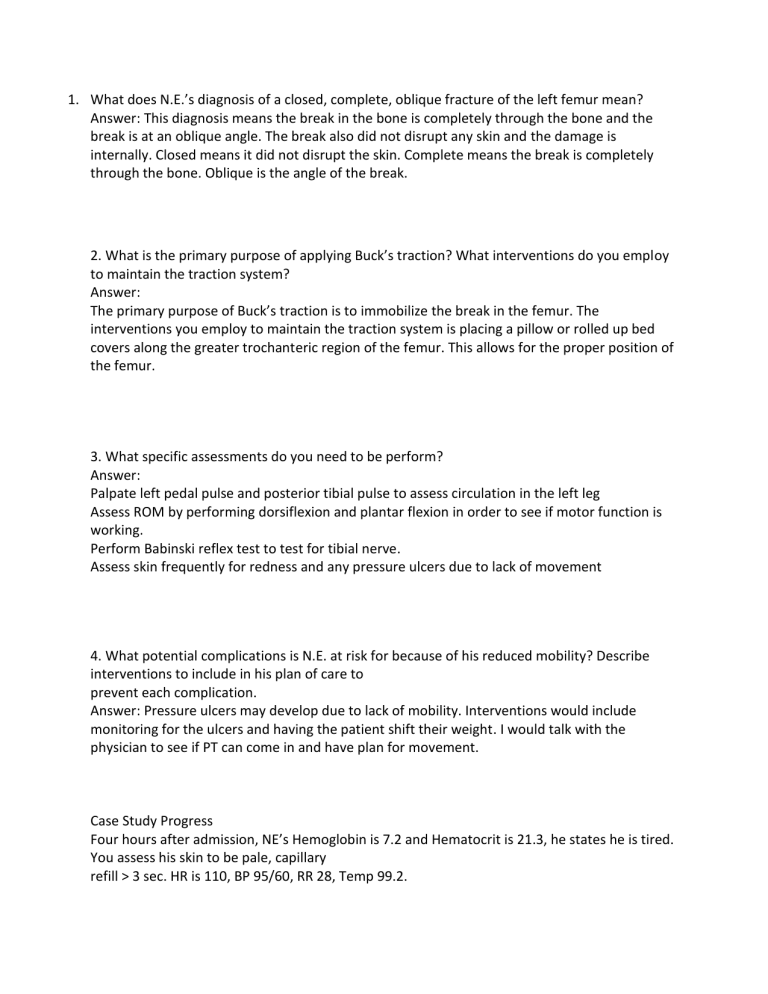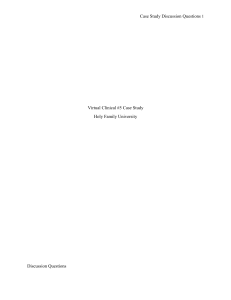
1. What does N.E.’s diagnosis of a closed, complete, oblique fracture of the left femur mean? Answer: This diagnosis means the break in the bone is completely through the bone and the break is at an oblique angle. The break also did not disrupt any skin and the damage is internally. Closed means it did not disrupt the skin. Complete means the break is completely through the bone. Oblique is the angle of the break. 2. What is the primary purpose of applying Buck’s traction? What interventions do you employ to maintain the traction system? Answer: The primary purpose of Buck’s traction is to immobilize the break in the femur. The interventions you employ to maintain the traction system is placing a pillow or rolled up bed covers along the greater trochanteric region of the femur. This allows for the proper position of the femur. 3. What specific assessments do you need to be perform? Answer: Palpate left pedal pulse and posterior tibial pulse to assess circulation in the left leg Assess ROM by performing dorsiflexion and plantar flexion in order to see if motor function is working. Perform Babinski reflex test to test for tibial nerve. Assess skin frequently for redness and any pressure ulcers due to lack of movement 4. What potential complications is N.E. at risk for because of his reduced mobility? Describe interventions to include in his plan of care to prevent each complication. Answer: Pressure ulcers may develop due to lack of mobility. Interventions would include monitoring for the ulcers and having the patient shift their weight. I would talk with the physician to see if PT can come in and have plan for movement. Case Study Progress Four hours after admission, NE’s Hemoglobin is 7.2 and Hematocrit is 21.3, he states he is tired. You assess his skin to be pale, capillary refill > 3 sec. HR is 110, BP 95/60, RR 28, Temp 99.2. 5. a. What do you suspect is happening with NE? b. Why is NE tachycardic and tachypneic? Answer: a. I believe due to the break in the femur, the body is not producing enough RBC. The femur is a large bone in the body and supplies a lot of the RBC in the body. The patient needs a blood transfusion due to his hemoglobin and hematocrit levels. The patient possibly is anemic as evidenced by the pale skin, high heart rate, and low BP b. The patient is tachycardic and tachypnea because of possible anemia. The heart is compensating for the lack of red blood cells by increasing its rate. 6. You notify the MD, and 2 units of Packed RBC’s is ordered. a. What are the safety alerts for blood transfusion? b. What are the nursing implications to begin the blood transfusion? c. What are the signs and symptoms of a transfusion reaction? d. What steps must the nurse take if a transfusion reaction occurs? Answer: a. Safety alerts include the nurse checking that it is the right patient, right blood type, and right dose before administration. The nurse should look for signs of a reaction. Symptoms of a reaction include fever, chills, pain, nausea, dyspnea, and changes in vitals. b. Nursing implication starts with verifying the order and explaining to the patient what procedure is going to take place. The blood should be at room temperature. A 18 G needle should be used for easy flow of the blood. The nurse should use aseptic technique when setting up the transfusion. 0.9% NaCl administered before and after transfusion. c. Symptoms include fevers, chills, hypotension, hemoglobinuria, and respiratory depression d. The nurse should immediately stop the transfusion. Monitor vital signs for adverse complications.




